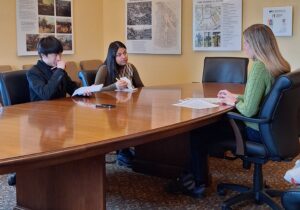Minnesota’s Department of Natural Resources is projected to receive $100.55 million for its projects how will Minnesotans see that change?
ThreeSixty Reporter Lennox Tan sat down with Samantha Minkler, the capital asset manager for the Minnesota DNR, to talk about the 2024 bonding bill’s effects on biodiversity and the environment.

Minnesota’s infrastructure is at stake in this year’s legislative session. The 2024 bonding bill, a large sum of borrowed money that infrastructure, community projects and large programs depend on $982 million, which is a large decrease from the 2023 bonding bill, totaling around $2.6 billion.
Gov. Tim Walz has requested the legislature to give the DNR $100.55 million. The Department of Natural Resources – a massive agency that maintains infrastructure, state parks, forests, recreational trails, manages the extraction of natural resources and much more – plans to spread the money across eight different programs. However in addition to numerous projects, will this funding be enough?
What are the DNR’s priorities with the 2024 bonding bill?
Our No. 1 priority is Natural Resources Asset Preservation (NRAP), which helps put money into deteriorating buildings. A lot of our infrastructure is at that point, so we need to do many full replacements.
In our NRAP proposal, this money can go toward DNR offices, but it’s also everything else we manage: Park visitor centers, camper cabins, vault toilets, storage buildings where we store our equipment that does firefighting and wildlife restoration, and even that is a small part of our infrastructure. We also have roads, trails, bridges – wildlife and aquatic community management areas. We have to continuously invest in those to keep them in good condition so that both people and animals can be safe.
And then to build new buildings, we have to meet the sustainability guidelines which improve energy efficiency and sustainability. We incorporate current stream flow and ecosystem design methodologies to account for the effects of heavier storms due to climate change. We incorporate those into the new design, and then it also helps improve fish and wildlife habitat.
Are there any specific projects that would be interesting to look at?
We’ll be building a new storage building for drill cores in the Hibbing Drill Core Library, which are stored samples of the Earth people in exploration send us that scientists can do tests on. We’re really looking forward to it because right now, our third building has just a little bit of storage left.
There’s also a lot of roads, trails and bridge projects. We’re hoping to fund beaches and campgrounds and there’s a couple of large public water access projects that are going to be high profile.
We’re also working toward having vehicles that have cleaner gas than regular fossil fuel vehicles, so we’re working with our fleet because our fleet is not only cars, it’s cars, trucks, firefighting equipment, snowmobiles, all types of things because we are all outside.
Do you think there’s adequate funding from this bonding bill to support these projects?
We have an immense need. For asset preservation alone, it requires at least $211 million annually to meet the needs that we have built up over time.
If we were to get the governor’s rec for that program, $71.5 million, it would be very helpful, but there’s much more. Last year, we received $36 million in asset preservation. What happens over time is we get a varied amount. It’s not consistent, and it’s hard to plan our asset management based on that. We might not get a bill for two, three or four years; and then we’re really looking for funding when we get a really large bill. We’re very thankful and looking forward to this amount, but we have more needs than that.
We can’t build new with the money except for the drill core project. So, $12 million will take up the drill core project. We had asked for $87 million because we have a lot of new things that we’d like to build. One of them is for the State Forest nursery, which will allow us to grow containerized tree seedlings. We don’t believe that will be funded this year, but we are still hopeful. I would love it if they would be able to fund that project. And then those trees would go out to certain communities and be able to be planted for reforestation.
Lennox worked with Madison McVan, a reporter with the Minnesota Reformer, and Harry Colbert, Jr., MinnPost Managing Editor, to finish his story. This story was completed at ThreeSixty’s Winter News Team: Capitol Edition in February 2024, where high school journalists covered important legislative issues, impacting Minnesota youth. Read more stories here.
